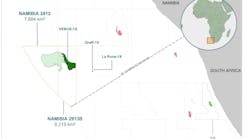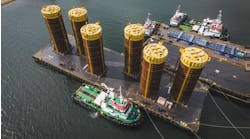Appraisal drilling
Operators are sizing up their deepwater discoveries this year with appraisal drilling. At print, appraisal wells had been spudded on Anadarko-operated Mission Deep in Green Canyon block 955 withNoble Amos Runner and on Claymore in Atwater Valley block 140 with Ocean Star. The wells were scheduled to reach TD by the end of 1Q 2007. Appraisal wells also were under way on ATP-operated Anduin in Mississippi Canyon block 755 with Ocean Quest and on BP-operated Puma in Green Canyon block 821 with Ocean Confidence.
Later this year, operators plan to conduct appraisal drilling on four lower Tertiary discoveries. They include BP-operated Kaskida in Keathley Canyon block 292 in 1,786 m (5,860 ft) of water, Chevron-operated Jack in Walker Ridge block 759 in 2,134 m (7,000 ft) and St. Malo in Walker Ridge block 768 in 2,103 m (6,900 ft) of water, and Shell-operated Great White in Alaminos Canyon block 857 in 2,441 m (8,009 ft) of water.
Deepwater well tests imminent
At least two deepwater well tests are planned for this year. One is a flow test of the discovery at Kaskida in KC block 292, expected in the second half of this year. This discovery is estimated to be the bigger than the Jack field.
Jack well No. 2 was drilled to 8,588 m (28,175 ft) TD and flow tested at 6,000 b/d of oil, representing 40% of the total net pay in the reservoir. The Jack discovery well No. 1, drilled in 2004, reached 8,839 m (29,000 ft) TD and encountered more than 107 m (350 ft) of net oil pay.
Chevron operates Jack with 50% working interest. Partners include Devon and Statoil with 25% each. An additional Jack appraisal well is scheduled for 4Q 2007.
The Kaskida discovery was drilled to 9,906 m (32,500 ft) TD and encountered 244 m (800 ft) of hydrocarbon-bearing sands.
Devon believes Kaskida is the largest of its four lower Tertiary discoveries to date. Its other three discoveries are Jack, St. Malo, and Cascade. Devon has identified 18 additional prospects along this trend. Devon has a 20% working interest in Kaskida. Partners include BP (operator) with 55% and Anadarko with 25%.
Lloyd’s Register to class Helix Producer I
Helix Energy Solutions has contracted Lloyd’s Register North America Inc. to provide classification and regulatory consulting services for the company’s ship-shaped floating production unit (FPU),Helix Producer I.
The foreign-flagged FPU will be the first in US waters to operate with a DP system and will feature a disconnectable transfer component to connect its production and export risers. This will allow quick disconnect from its risers to avoid tropical storms and hurricanes.
The floater will process oil and gas from subsea wells 137 km (85 mi) off the Louisiana coast in 610 m (2,000 ft) of water.
“With this award, we can clearly see our long-term strategy coming into focus for offshore development projects in the GoM,” says David Corbett, senior vice president of energy and transportation for Lloyd’s Register America.
At the beginning of this year, Lloyd’s received authorization from the US Coast Guard to review plans and to conduct inspections on floating offshore installations (FOIs) in US waters, including the GoM outer continental shelf. FOIs include TLPs, semisubmersibles, spars, and FPSOs.
The authorization results in an expansion of Lloyd’s current portfolio of services in Canada, Mexico, and Brazil.
According to Lloyd’s, in the past, some floating offshore projects suffered expensive delays due to a shortage of authorized personnel involved with the approval process, creating backlogs for offshore operators with new projects.
“With our new authorization, operators in the GoM should benefit from fewer delays and lower costs for their deepwater projects as well as a fresh set of eyes to identify and examine safety-critical elements on their assets,” says Bill Westcott, vice president of Lloyd’s Register America’s energy and transportation division.
In 2005, Lloyd’s was granted a similar authorization under the alternative compliance program to inspect US-flagged mobile offshore drilling units.
Petrobras hits milestone
Petrobras has turned on the taps on its first deepwater project, as operator, outside of Brazil.
The operator has brought online the first well on its 100%-owned Cottonwood field at 40 MMcf/d of gas. A second well was scheduled to start flowing at the end of February to boost production to 20,000 boe/d (70 MMcf/d plus condensate).
J Ray McDermott’s derrick bargeDB-50 installs a process module on Cottonwood’s host platform.
The Cottonwood field is in Garden Banks block 244 in 670 m (2,198 ft) of water. The field’s two subsea wells are tied back via 27 km (17 mi) of 152-mm (6-in.) pipeline to the W&T-operated and Enterprise-owned fixed platform in East Cameron block 373.
The Cottonwood discovery was drilled in June 2001 by Kerr-McGee as operator, with Petrobras holding a 33.3% working interest.
Petrobras acquired 100% interest in the field in December 2004.
ATP plans Gomex expansion
ATP plans to tie back recently acquired properties to its 100% owned and operatedATP Innovator floating production unit on Gomez in Mississippi Canyon block 711.
The company has acquired an interest in a package of properties, including a 100% working interest in the Anduin discovery in MC 755, adjacent to Gomez. The MC 755 No. 2 discovery well was drilled in 2005.
ATP intends to establish production at Anduin later this year by side tracking, completing, and tying back the discovery well to the semisubmersible.
Following completion of Anduin, the company will earn interest in two prospects; a 50% working interest in MC 754 (Anduin West) and a 25% working interest in MC 800 (Gladden). Gladden is scheduled to spud later this year, followed by Anduin West in 2008.
If the side tracks encounter commercial hydrocarbons, the two prospects will be tied back to theATP Innovator.
“This transaction also allows third-party access to the Gomez facility, and thus our production facility should operate at close to maximum capacity for a substantially longer period of time than previously expected,” says Paul Bulmahn, ATP chairman and president. “ATP will continue to acquire interests in offshore blocks that are near our existing infrastructure,” adds Gerald Schlief, ATP senior vice president.
CERA study: rising cost diminishing returns
Cambridge Energy Research Associates (CERA) says despite record high natural gas prices in recent years, fewer reserves are being added for every dollar of E&P activity. Furthermore, higher costs are undermining the economics of an increasing number of wells. These are the findings of CERA’s first-ever analysis of full-cycle cost data. The analysis includes data for 2005.
The study also identifies the dramatic shift toward unconventional gas production, which now accounts for a quarter of total output.
A multi-client analysis by CERA and IHS looks at cost and production data for the 48,000 wells completed in all 50 North American natural gas basins (232 individual plays) in 2005 and finds that capital costs alone (excluding operating costs, royalties, and return) ranged from $1/Mcf of reserves to over $6/Mcf.
The weighted average all-in cost ranged from below $4/Mcf to over $12/Mcf. Judged against the record prices of 2005, which averaged $8.80/Mcf at Henry Hub, over 6% of the basins had high enough costs that they would fail to achieve a 10% rate of return on investment.
“Record prices in 2005 triggered a tremendous response in drilling by gas producers, leading to nearly decade-high reserve additions of 26.4 tcf and added production of 14.7 bcf that year,” says J. Michael Bodell, CERA director of upstream gas strategies. “Nevertheless, despite a nearly threefold increase in the number of rigs deployed to drill natural gas wells over the past decade, North American gas production has remained stubbornly flat, and the cost of new gas supply has risen substantially due to higher drilling and operating costs and, most significantly, declining average well productivity and initial production rates.”
The study found that E&P companies are developing smaller resources and facing higher costs, with the inevitable result that unit costs have moved much higher. However, within this overall trend, many regions, by contrast, have very strong margins and provide returns on equity well beyond 10%.
“The E&P companies that have shifted their portfolios to include these lower-cost resources, particularly the early movers, are recognizing substantial cost advantages,” says Bodell.
The CERA/IHS analysis finds that a combination of higher prices and improved drilling and rock fracture technology has accelerated the development of unconventional resources, which accounted for 23% of total North American gas production in 2005 compared to 11% in 1995.
2006 reserve additions near 10-year high
The year 2006 has been exceptional for exploration in the deepwater Gulf of Mexico. While the success rate remained on par with recent years, early estimates suggest that total reserves discovered could be in the region of 1.5 Bboe, according to Wood Mackenzie in its 2006 review of US Gulf of Mexico exploration. The study looks at trends in deepwater drilling and reviews 2006 deepwater discoveries.
The discovery rate per deepwater Gulf of Mexico well is up in 2006 due to potentially large discoveries at BP’s Kaskida and Hess’ Pony fields. (Source: Wood Mackenzie’s Treasures of the Deep - A Review of 2006 Exploration)
Over the last 10 years, the average amount of oil and gas discovered each year in the deepwater Gulf has been about 1.2 Bboe, according to the report. More disappointing were 2004 and 2005, with reserve additions falling to below 1 Bbbl.
The 2006 result is due to two potentially very large finds, one by BP at Kaskida (KC 292) and the other by Hess at Pony (GC 468). Together, these fields account for over half the reserves discovered in the region during the year. The 2006 discovery rate per well drilled was over 40 MMboe. This is the highest recorded since 1999, when the yearly total was swelled by the discovery of Thunder Horse.
The successes of 2006 show that big finds still are to be made in the GoM. It remains one of the top deepwater hunting grounds in the world, concludes the report.
Apache may slash E&D budget
Apache projects its capital budget for North America this year will be down $600 million over its 2006 numbers, said Steven Farris, Apache president, CEO and COO, in the company’s 4Q 2006 conference call.
The company is reducing its budget due to weakening gas prices and higher service costs in 2006. Last year, Apache received $6.54/Mcf of gas sold, down from $7.22/Mcf in 2005.
As a result, the company said it is shifting about $500 million from North America to abroad to pursue higher growth at a lower cost.
“While service costs have moderated somewhat from the unsustainable levels of 2006, a rebound in costs would require Apache to revisit its 2007 capital plans, especially in North America, which experienced the greatest cost increases,” Farris said.
“North America is the area by far that has the most volatility in service costs, and it’s the easiest area for us to move quickly to change our activity level,” he added.
The company spent $2.9 billion for exploration and development in North America in 2006, $1.2 billion of it in the Gulf of Mexico.
Apache plans to drill 54 wells in the GoM in 2007. The company is the largest acreage holder and the second largest producer in Gulf waters of less than 366 m (1,200 ft) deep.






